Physical Address
304 North Cardinal St.
Dorchester Center, MA 02124
Various congenital abnormalities involve the pulmonary system. Some of these result in arrested development and stillbirth. Some infants survive delivery only to die shortly thereafter. Neonates with severe anomalies typically display dyspnea and cyanosis at birth. Older children with less critical anomalies may have feeding problems, respiratory infections, developmental delays, or activity limitations. For neonates who are in respiratory distress, speed of diagnosis and early treatment are critical. Intubation may be life-saving. Examination of the naso-oropharynx, neck, and chest along with an emergent radiograph allows rapid diagnosis in most cases. Quality computed tomography (CT) may be necessary to delineate the anomaly. Other important adjuncts that may enhance diagnostic speed and accuracy are echocardiography, magnetic resonance imaging (MRI), and endoscopy.
During the past decade, improvements in prenatal diagnosis have allowed intrauterine repair of some defects. With non–life-sustaining defects such as anencephaly and renal agenesis, parents may opt for pregnancy termination. For potentially correctable lesions, the pregnant mother can be transferred to a tertiary medical center. Advanced supportive and surgical techniques have led to improved survival in these infants.
The first report of a congenital lung defect was by Fontanus in 1639, describing an infant with a lung cyst. In 1777, Huber described an infant with an intralobar sequestration, with blood supply from the thoracic aorta. In the mid-1800s, an extralobar (Rokitansky lobe) sequestration was reported. The neonatal prevalence of lung infections in the 1900s was so high that it was difficult to formulate concepts of congenital lung disease, and the technology was not sufficiently advanced to correct such defects. In 1917, Gladstone and Cockayne theorized how sequestrations occurred, and in 1925, Koontz reviewed congenital pulmonary cystic diseases. The first surgical correction of a congenital lung anomaly was performed by Rienhoff in 1933, that being local lung cyst excision in a 3-year-old boy. Gross and Lewis performed the first pediatric lobectomy in a child with congenital lobar emphysema. Cystic disease in the right upper and right middle lobes was resected by lobectomy in 1943. In 1946, Gross performed a pneumonectomy in a 3-year-old with cystic lung disease. Potts performed the first neonatal lobectomy in 1949. Lewis later reported the death of a child on whom a lobectomy was being performed for intralobar sequestration, citing exsanguination after lost control of the systemic feeding artery. With development of advanced supportive, anesthetic, vascular, and bypass techniques, the mortality rate for children at high risk for congenital lesions has significantly decreased.
Lung development occurs both prenatally and postnatally and continues into adulthood. Intrauterine pulmonary development is divided into four phases: embryonic, weeks 1 to 5; pseudoglandular, weeks 5 to 16; canalicular, weeks 16 to 26; and terminal sac, weeks 26 to birth.
During the embryonic phase, the foregut begins to develop from the embryonic endoderm beginning on day 9, and the median pharyngeal groove develops from the foregut on day 22. At approximately 4 weeks of gestational age, the respiratory diverticulum, or lung bud, emerges as a 3-mm outpouching from the ventral wall of the embryonic foregut. The respiratory diverticulum at this stage is surrounded by splanchnic mesenchyme that later gives rise to the visceral pleura. Concurrently, the lateral mesoderm grows to form the tracheoesophageal septum, effectively separating the tissues that will become the lung from those that will become the esophagus. The lung bud initially forms the trachea, followed by two bronchial buds that enlarge to form the right and left main bronchi by the start of the fifth week. The individual five lobes become evident during the next few weeks.
In the pseudoglandular stage (weeks 5 to 16), the bronchial tree develops, including the cuboidal and columnar epithelial layers and cartilaginous rings. Repetitive branching of the bronchial tree during this stage gives rise to all the conducting airways. The pulmonary vasculature develops in tandem with the airways; however, the airways and pulmonary arterial branches remain separated by mesenchyme. By the 16th week, the bronchial tree and the pulmonary arteries are fully formed, and the common pulmonary vein drains into the sinoatrial region of the heart.
In the canalicular phase (weeks 16 to 26), respiratory bronchioles divide to form alveolar ducts, and the mesenchymal separation of the airways from pulmonary arterial branches begins to recede, allowing the first appearance of the air-blood barrier. By the 25th week, the pulmonary venous drainage has completely developed.
The terminal sac period (weeks 26 to 40) is marked by continued extension of the air-blood barrier. The primitive alveoli proliferate and become intimately involved with the surrounding capillaries as the mesenchyme separating them thins out. Terminal sac formation from the terminal lung buds occurs in a coordinated interaction between promoter factors, such as fibroblast growth factor 10, and inhibitory factors, such as Sonic hedgehog and transforming growth factor β 1 . Mechanical fluid pressure on the terminal lung bud also appears to play a critical role. The adult form of alveoli has developed by the 30th to the 36th week, and the airways are almost fully developed before term. Type II pneumocytes produce surfactant in preparation for delivery.
Lung development continues postnatally with alveolar multiplication that results from progressive septation within the terminal sacs. Septation is driven by transcription factors, growth factors, and extracellular matrix molecules and is closely tied to sprouting angiogenesis (under the influence of vascular endothelial growth factor), followed by the splitting and remodeling of alveolar capillaries. Immediately after birth, alveoli are fairly thick walled and number approximately 20 million, less than 10% of their eventual number. Acinar development continues to the eighth year of life, but the rate of development diminishes after the second to fourth years. By the end of the eighth year, there are approximately 300 million acini, and after the tenth year of life, alveoli enlarge rather than increase in number. The lung-environmental interface increases from 3 to 4 m 2 at birth to 75 m 2 in adults. From birth to the age of 5 years, airway diameter increases; after the age of 5 years, the proximal airway grows at a faster rate than the more distal airways. The trachea is initially funnel-like but becomes more cylindrical by the age of 4 years. Pulmonary vessel length and diameter rapidly increase until 18 months of age.
Normal airway and vascular development depends on a variety of factors. These include cell-to-cell interactions, local and systemic hormones and growth factors, central and peripheral neural influences, and chest wall effects. The latter involve contact influences of the bony and muscular structures. Alterations in normal development may result from defects in any of these factors. Viral infection, hypoxia, starvation, and teratogens also may disrupt normal lung development. In utero airway obstruction may produce a variety of lesions. Of these patients, 84% have additional nonpulmonary anomalies.
Three major hypotheses have been formulated to explain the pathogenesis of anomalous tracheobronchial development.
The reduction theory postulates that the final anatomy is the result of shrinkage and finally suppression of portions of a primitive pattern encompassing all the components of the extant mammalian bronchial distribution.
The migration theory considers that bronchial outgrowths have the potential of migrating from their initial locus to new points of origin of a bronchus or the trachea.
The selection theory advocates local disturbances in the development during budding of the bronchial buds under the influence of bronchial mesenchyma.
Lung resection in neonates and children is fairly well tolerated. Anatomy is easily defined because there is less mediastinal and hilar fat, adenopathy, and scarring from chronic disease compared with adults. Outcomes after pediatric lung resection are good. Children younger than 5 years develop new alveoli after resection. In those older than 5 to 10 years, the alveoli enlarge, although they no longer increase in number. In an infant pneumonectomy model, lung function returns to normal within 9 to 12 months. Emphysematous changes do occur, as in adults. After lung resection in children in whom the remaining lung is normal, the child appears to grow, develop, and perform normally with maximal exercise. The diffusion capacity for carbon monoxide is reduced and pulmonary artery pressure increases with exercise, but pulmonary vascular resistance is normal after resection.
Payne first described congenital absence of the trachea in 1900. Fewer than 150 cases have been reported. It represents a partial or complete absence of the trachea below the level of the normal larynx. This abnormality is incompatible with life if there is no connection of trachea or bronchi to the esophagus. Floyd and others classified three distinct types of tracheal agenesis ( Fig. 9-1 ). In type I, the trachea originates from the esophagus, and the distal trachea, including the carina, is fairly normal. Type I represents 10% to 13% of the total number of tracheal agenesis cases. In type II, the trachea and carina are fused to the esophagus, and there is no residual trachea. Type II represents 59% to 62% of the total. In type III, the left and right mainstem bronchi originate from the esophagus, and there is no carina. Type III represents 22% to 31% of the total. Male incidence predominates in a 2:1 ratio. In 90% of the cases, there are other congenital lesions. Tracheal agenesis may be associated with VACTERL ( v ertebral, a nal, c ardiac, t racheal, e sophageal, r enal, and l imb patterns of congenital anomalies) or with complex congenital heart defects as well as with upper extremity defects and duodenal atresia (referred to as TACRD). It is believed that tracheal agenesis is the result of developmental failure of the laryngeal tracheal bud at the third to sixth week of development. The tracheoesophageal septum fails to develop normally. Antenatal diagnosis of tracheal agenesis offers the best chance of early treatment. The usual findings include polyhydramnios, fluid-filled and dilated esophagus, distended lungs, an inverted diaphragm, and fetal hydrops. Many of these features are similar to those found in congenital high airway obstruction syndrome (CHAOS), thus suggesting that these abnormalities may be components of the same spectrum and differing only in severity and extent. It is important to differentiate between tracheal agenesis/atresia and CHAOS because ex utero intrapartum treatment (EXIT) may be life-saving for CHAOS but has not been described for tracheal atresia.
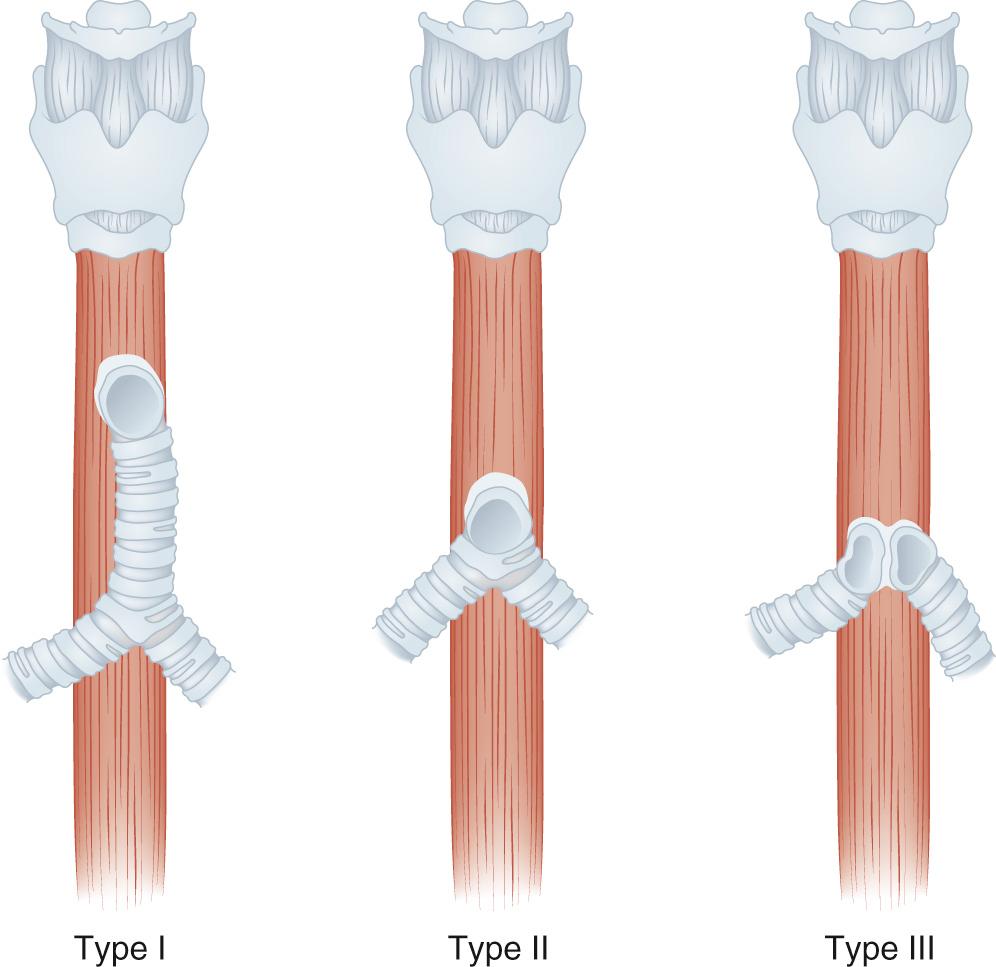
Neonates usually present with a triad of severe respiratory distress, the inability to cry, and the inability to be intubated. Survival is unlikely, although there are a few cases of survival reported in the literature. Those who are successfully managed are endoesophageally intubated, with a nasogastric tube alongside the endotracheal tube for gastric decompression. Urgent bronchoscopy or tracheostomy can assist in diagnosis. CT scan is the procedure of choice for delineating the anatomy in a newborn. A survivor is described who had a type II defect and underwent esophageal intubation, gastrostomy, and distal esophageal banding. The patient is reported to have survived to 4 years, undergoing a colonic interposition at 3 years of age. A second patient is described with a type I defect who survived to 6 years of age. Extracorporeal membrane oxygenation (ECMO) may temporize these patients until a more definitive solution can be achieved. If the patients can be stabilized, they should be examined for other life-threatening defects, such as neural and cardiac anomalies, that may require correction. The gastroesophageal continuity can be corrected with colonic interposition or gastric conduit, but there have been no attempts to reconstruct the trachea. Perhaps, for the future, to reconstruct the incompletely developed airway, tracheal allografts or tissue-engineered replacements may be used for long-term success.
Congenital tracheal stenosis ( Fig. 9-2 ) is rare. Cantrell and Guild described three forms of stenosis. Type I is stenosis of the full length of the trachea. Type II is a funnel-shaped stenosis of the upper, lower, or entire trachea. Type III is a segmental stenosis of the lower trachea. This classification assists in identifying patients who are more likely to have associated anomalies and in planning treatment. Stenotic regions have complete cartilaginous rings, the number of which is variable, anywhere from 2 to 18. This rare anomaly is associated with pulmonary vascular sling or vascular ring in 50% of cases. A functional classification system has been proposed to assist in selection of the operative candidate.
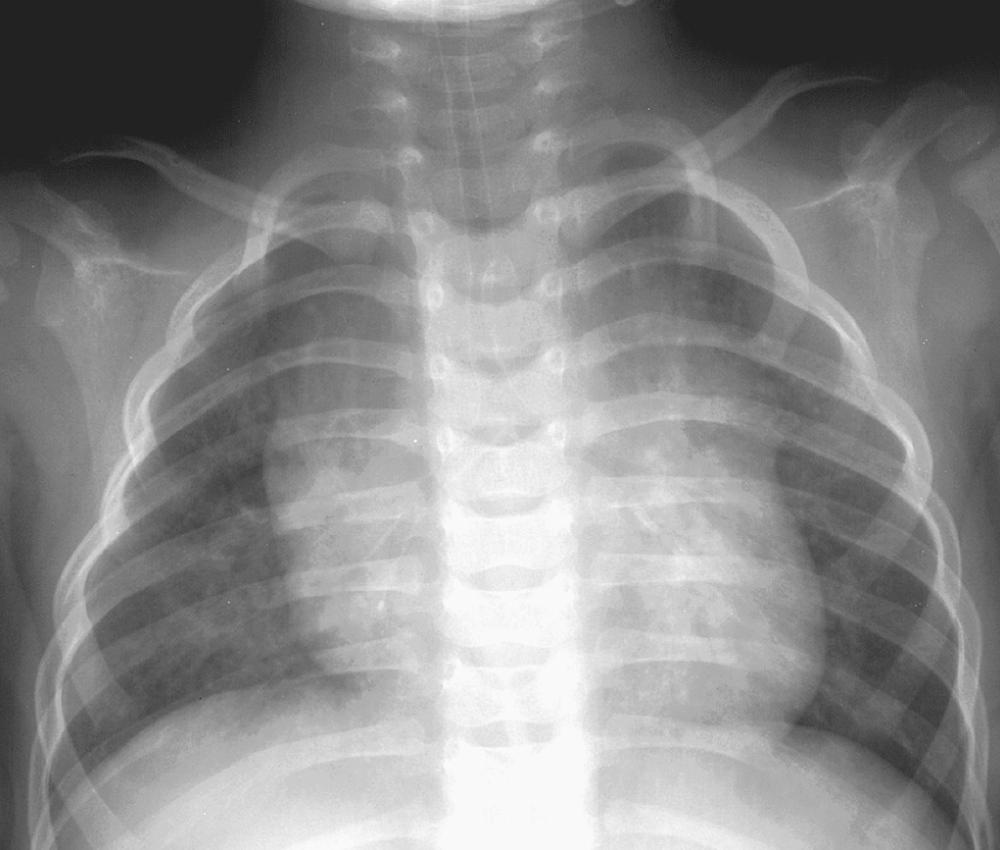
These patients usually have exertional wheezing or stridor after birth. The type II and type III abnormalities are associated with anomalous location of one or more bronchi, most likely a left pulmonary artery sling. All three types are associated with pulmonary agenesis. A new morphologic classification has been proposed and is based on the bronchial arborization pattern, thus introducing the term congenital tracheobronchial stenosis . Symptoms vary according to the degree of stenosis. Patients presenting during the neonatal period or infancy with severe stridor, cyanosis, and recurrent stridor have the highest mortality rate. Many of these patients have associated congenital malformations and infections. Their prognosis, even after surgical correction, is variable. Older children presenting at 1 year of age or soon thereafter have a surgical mortality rate of 10% to 20%. Some children, late in childhood or early teens, may present for an evaluation for asthma with varying degrees of exertional dyspnea. Typically, these children have a better prognosis. CT, especially multidetector CT, works better than flexible bronchoscopy because it provides enough detail to not only assess the tracheobronchial abnormality with a sensitivity of 90% but also to assess any associated anomalies. Bronchoscopy aids in diagnosis, treatment planning, and evaluation of the surgical repair intraoperatively and postoperatively. Echocardiography is helpful to assess for cardiac and vascular anomalies. Patients should be aggressively treated because, without surgical correction, they are at high risk for sudden death. Partial tracheal resection is the most frequently performed operation. The neonatal trachea does not tolerate tension as well as the adult trachea. Up to 50% of the infant trachea can be resected with primary reanastomosis. The repair is much more difficult if more than 50% of the trachea or the carina is involved.
In 1964, the first repair, a primary resection and end-to-end anastomosis, was reported by Cantrell and Guild. Reconstruction has been performed with pericardium, aortic homograft, costochondral graft, slide tracheoplasty ( Fig. 9-3 ), and tracheal autograft. Complete repair of the tracheal stenosis and any vascular ring or sling requires cardiopulmonary bypass and potential circulatory arrest. Backer and coworkers reviewed their 18-year experience in 50 patients, comparing four tracheal stenosis repair techniques : pericardial patch, primary resection, tracheal autograft, and slide tracheoplasty. They concluded that when eight or fewer rings are involved, primary resection is preferable. For stenosis longer than eight rings, an autograft is better. Vascular endothelial growth factor application has the potential of improving the results of tracheal autograft. In contrast, Muraji and coworkers demonstrated that the slide tracheoplasty technique allowed early extubation and an excellent long-term result in one case. Currently, slide tracheoplasty is the operation of choice for long-segment tracheal stenosis. ECMO may be necessary to support the neonate postoperatively. Long-term outcome after resection appears to result in normal growth and development. For patients who are considered surgically uncorrectable, palliative maneuvers include balloon dilation and split posterior tracheoplasty, stenting, local steroid injection, electroresection, and cryotherapy.
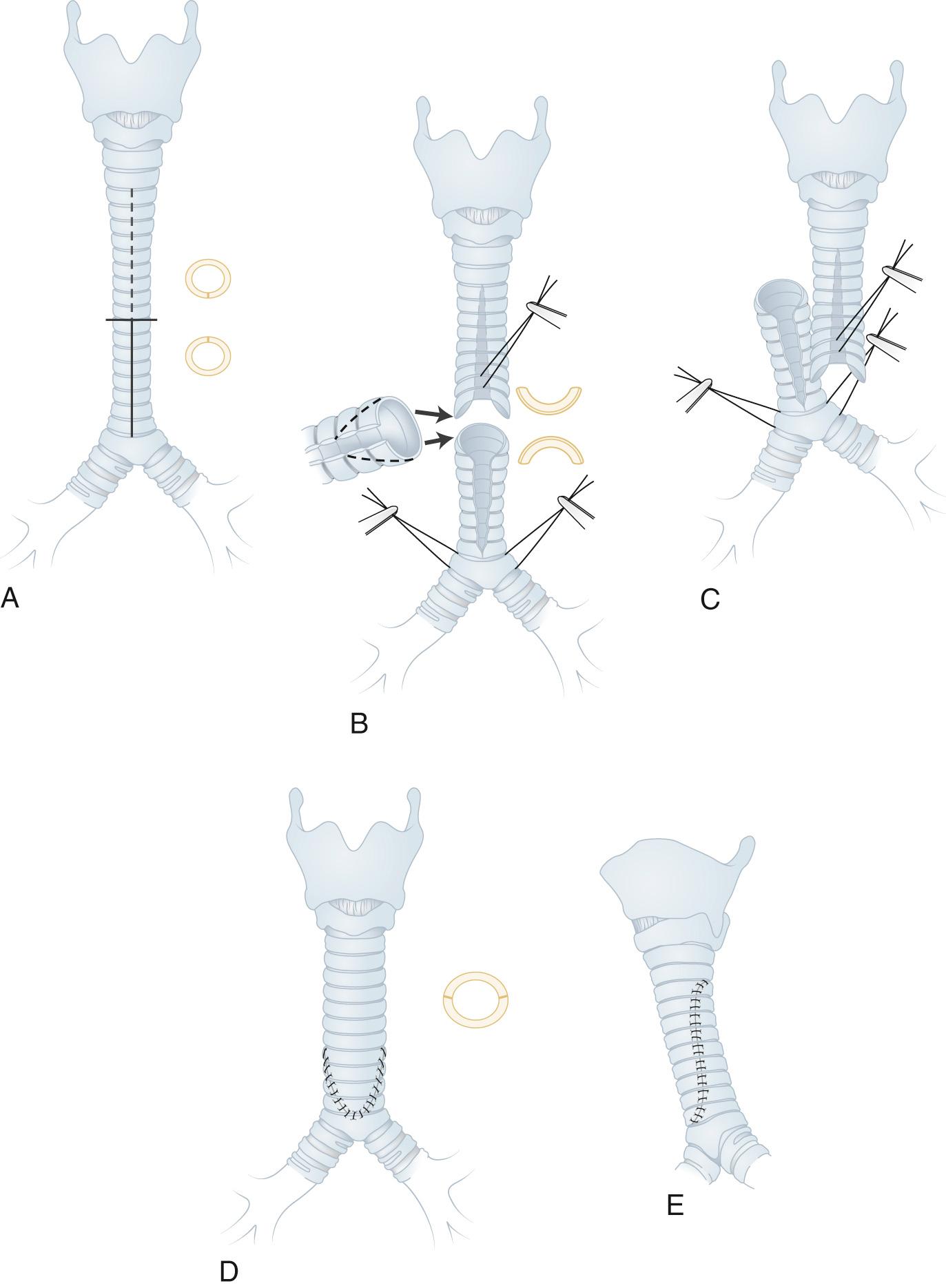
In tracheomalacia, weakened cartilage collapses on expiration. With inspiration, there is sufficient suspension of the tracheal wall to maintain patency. The most common pathologic finding is oval rather than round cartilaginous rings. There are both congenital and acquired forms of tracheomalacia. The congenital form can be diffuse and both proximal and distal, involving the mainstem bronchi; it is associated with tracheoesophageal fistula. The more common, acquired form results from degeneration of the cartilaginous support, usually by vascular compression such as from a vascular ring or sling, adjacent inflammatory process, tumor, or chest wall deformity (e.g., pectus excavatum).
Tracheomalacia is not usually manifested at birth. It worsens as the child grows, usually after several weeks of life. Coughing, respiratory distress, severe dyspnea, stridor, and cyanosis can occur. Acute apnea, referred to as “dying spells,” is the most severe presentation. Dyspnea worsens with agitation or respiratory tract infections. These severe symptoms should prompt further investigation.
One fourth of all patients with esophageal atresia have tracheomalacia. Tracheoscopy, bronchoscopy, esophagoscopy, and esophagography may be necessary for complete evaluation. CT and MRI provide additional information. The differential diagnosis includes normal pulsatile collapse, bronchial webs, and tracheal tumors. Many patients suspected of having tracheomalacia may instead have gastroesophageal reflux disease or reflux disease in addition to tracheomalacia. This may warrant either a trial of a proton pump inhibitor and prokinetic agent or a formal evaluation for reflux.
Tracheomalacia improves with age in most cases. Dying spells (acute life-threatening events), inability to be weaned from the ventilator, and failure to thrive are indications for more aggressive therapy. If tracheomalacia is mild, the infant should be supported and observed because infants usually outgrow their tracheomalacia within the next 2 years. In more severe forms, the mortality rate is as high as 80% with conservative management. Stents have been used with varying success to allow cartilage maturation; this usually takes several months. Tracheostomy also has been used but is associated with some complications. Aortopexy ( Fig. 9-4 ), by itself or with tracheal resection or stenting, has been performed by a left submammary thoracotomy through the third interspace or through a median sternotomy. The thymus is preserved. After exposure of the ascending aorta, three or four nonabsorbable sutures are placed through the aortic adventitia above and below the innominate artery takeoff. These sutures are attached to the periosteum. Finally, the endotracheal result is visualized by intraoperative bronchoscopy. By 4 weeks, 80% of the patients are extubated, and the long-term results are good. The acquired form is treated similarly to the congenital form. Longer segment lesions without vascular compression often require tracheostomy and mechanical ventilation for a time. Bronchomalacia may require both aortopexy and pulmonary artery pexy. The failure rate after aortopexy ranges between 10% and 15%. Direct anterior tracheal suspension is gaining popularity. This is performed through a median sternotomy, and the space between the superior vena cava and the aorta is developed. Sutures are passed into the tracheal wall, brought out through the sternal tables, and tied under direct bronchoscopic visualization. Mitchell and colleagues report on 21 such procedures performed with excellent results.
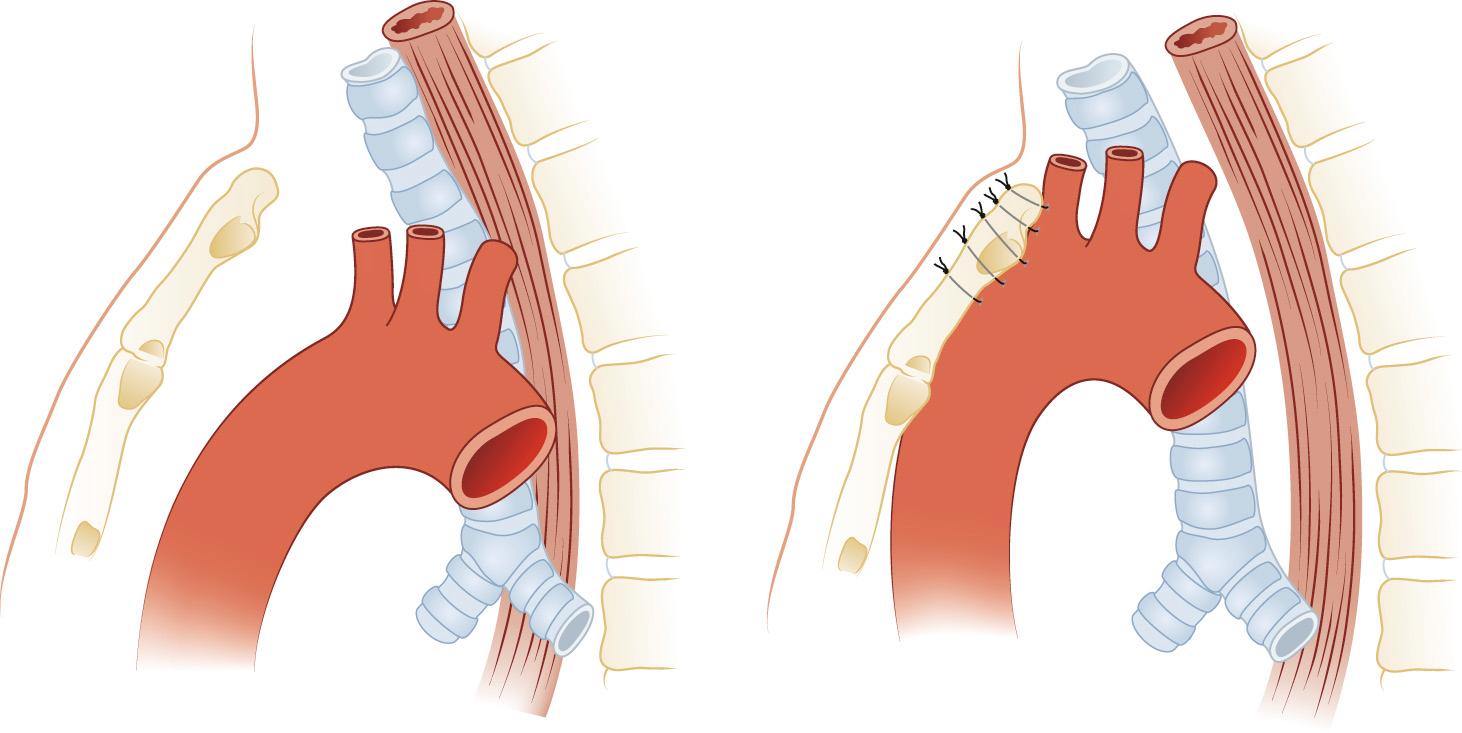
Bronchial branching abnormalities are rarely symptomatic. Accessory bronchi can originate off the trachea or mainstem bronchi and may be attached to rudimentary lung. They are usually incidental findings at autopsy. Cervical diverticula present in utero may regress before birth. There are case reports of bronchi crossing the mediastinum to supply the opposite lung. Tracheal bronchus, or bronchus suis, is a congenital branching anomaly in which the bronchus arises directly from the trachea above the carina ( Fig. 9-5 ). The most frequent tracheal bronchus is to the right upper lobe. These abnormalities may be isolated or associated with other tracheopulmonary anomalies. They can be associated with wheezing, stridor, pneumonia, bronchiectasis, and hemoptysis. Accessory bronchi and associated abnormal pulmonary tissue should be resected if symptomatic. Chest radiography and high-resolution CT are helpful in defining the anomaly. Fiberoptic bronchoscopy, bronchoalveolar lavage, and biopsy have been used to evaluate the abnormality. Endobronchial aspiration, lung resection, and transplantation have all been methods of treatment.
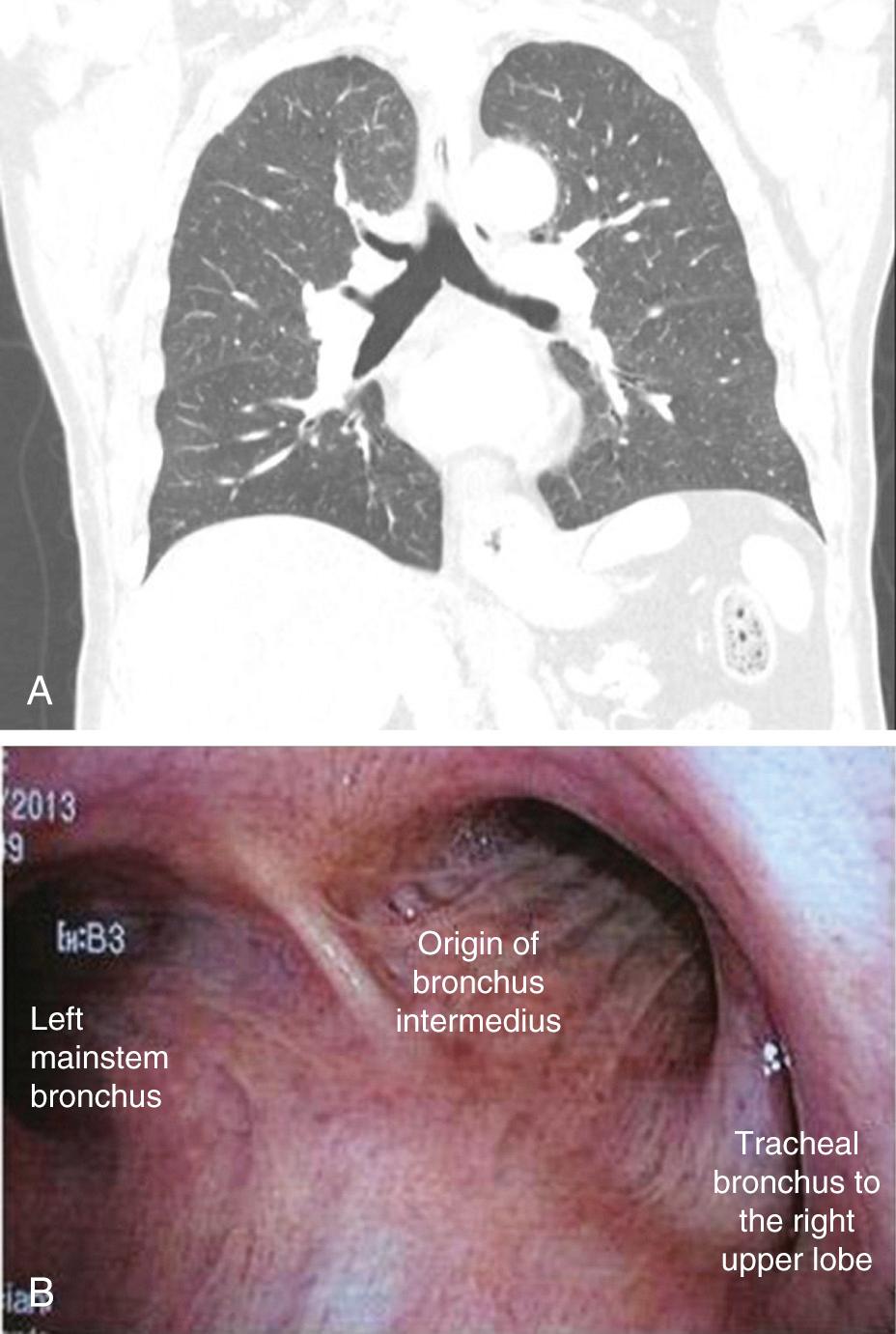
The following are anomalies that are more frequently symptomatic, potentially life-threatening, and possibly treatable.
Bronchial atresia, first described by Ramsay and Byron in 1953, is the second most common abnormality of the airway after tracheoesophageal fistula. A lobar or segmental bronchus ends blindly in the lung tissue. Lung tissue distal to the bronchial atresia expands and becomes emphysematous as a result of air entering through the intra-alveolar pores of Kohn and bronchoalveolar channels of Lambert. Beyond the atretic segment but proximal to the hyperinflated lung, the terminal airway is filled with mucus. It is believed that the bronchial bud somehow separates distally from the proximal bronchial bud and continues to develop. Another potential explanation is that there is a vascular insult of the airway in the atretic segment. In either case, the distal airway continues to develop normally.
Infants usually develop respiratory distress 4 or 5 days to several weeks after birth. They may have wheezing, stridor, and repeated pulmonary infections. The most common location is in the left upper lobe, then the left lower lobe, followed by the right upper lobe. A segmental bronchus rather than a lobar bronchus is atretic, most frequently presenting as a lung mass on the first chest radiograph of the newborn. Fetal lung fluid is slowly absorbed, becoming a localized translucency with an opaque circular or oval density at the hilum. Patients rarely mature to adulthood without investigation.
For better assessment of this abnormality, a CT scan should be performed. Prenatal diagnosis by ultrasonography has been reported. The differential diagnosis includes acquired bronchial stenosis (which may result from long-term intubation), bronchial adenoma, sequestration, mucoid impaction, vascular compression syndrome, Swyer-James syndrome, and atypical bronchogenic cyst.
Indications for resection in bronchial atresia include a recurrent and possibly serious pulmonary infection, respiratory distress, and increasing size of the translucent lung. Some surgeons resect the abnormal tissue to prevent infection. Segmentectomy is possible, but lobectomy is usually required.
Bronchiectasis is an abnormal dilation of the bronchi or bronchioles. It is thought to be secondary to failure of the mesenchyme to differentiate into cartilage and muscle. It is not a specific disease entity per se, but the common end stage of a variety of pathophysiological processes. Cystic fibrosis, primary ciliary dyskinesia, Young syndrome, Williams-Campbell syndrome, α 1 -antitrypsin deficiency, and certain primary immune deficiency syndromes are associated with bronchiectasis. It results in a chronic, mildly productive cough with recurrent pneumonia. CT usually confirms the diagnosis, and bronchoscopy typically is unnecessary. Bronchography is rarely necessary, given the detail provided by high-resolution CT. Treatment and prognosis depend on the number of segments or lobes involved. Patients are provided with humidity, chest physiotherapy, and oxygen, as necessary. Therapeutic bronchoscopy is performed for suspected mucoid obstruction or bleeding. Bleeding is initially controlled by embolization, topical epinephrine, or intravenous pitressin. Oral, intravenous, and nebulized antibiotics may be helpful in controlling symptoms. Patients who have localized congenital symptomatic bronchiectasis may require a segmentectomy, lobectomy, or possibly pneumonectomy. The success of surgical intervention is related to the ability to resect all the diseased lung.
Tracheobronchomegaly was first described in 1932 by Mounier-Kuhn. It is characterized by excessive dilation of the trachea and main bronchi ( Fig. 9-6 ). This dilation is the result of atrophy of the elastic tissue and smooth muscle of the trachea and mainstem airways. Airway dilation continues to third-order subdivisions. During the course of the disease, mucosal herniations develop between tracheal rings, creating a diverticulosis pattern. Associated conditions include cutis laxa, Ehlers-Danlos syndrome, Marfan syndrome, Kenny-Caffey syndrome, ataxia-telangiectasia, ankylosing spondylitis, Brachmann–de Lange syndrome, and light chain deposition disease. When an isolated process occurs, there is recessive inheritance. Tracheobronchomegaly also may result from severe pulmonary fibrosis with increased traction on the tracheal wall. As these diverticula develop, mucus retention occurs with resultant development of bronchiectasis and fibrosis. Patients eventually are unable to clear secretions, and they succumb to chronic infection and respiratory failure.
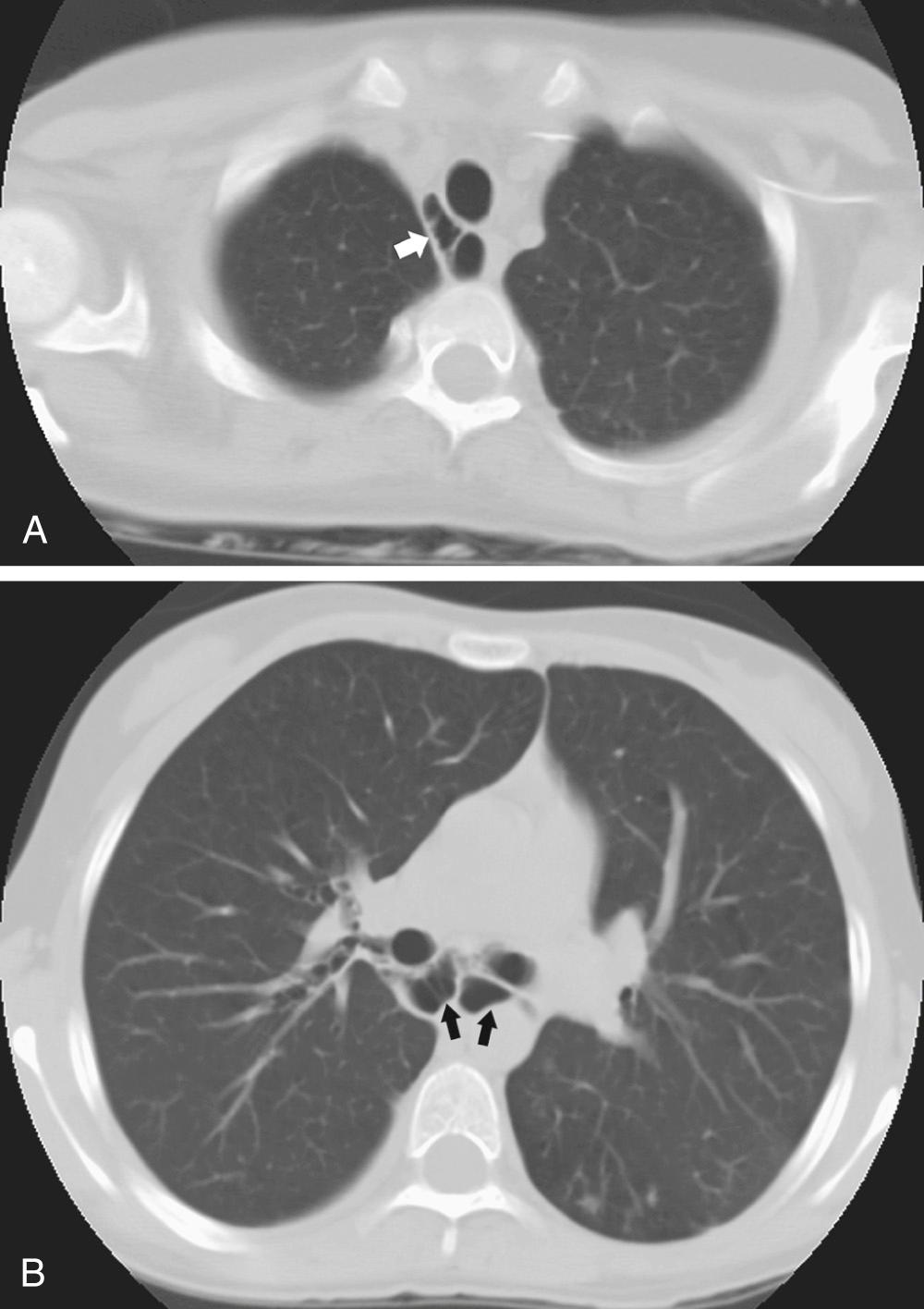
The patients are usually men in their third to fourth decades of life. Fifty percent of patients with tracheobronchomegaly have no symptoms until their third decade. They usually have recurrent lower respiratory tract infections. Asymptomatic patients may be identified in that the trachea is three standard deviations larger than normal; for adults, it exceeds 3 cm. Patients with tracheobronchomegaly frequently have recurrent respiratory tract infections and persistent cough. Plain chest radiography demonstrates an enlarged trachea and mainstem airways that may be ectatic. CT more clearly demonstrates changes, and tracheal dimensions for adults and children are helpful in making the diagnosis. Bronchography may be necessary to differentiate it from acquired bronchiectasis. Bronchoscopy generally is unrewarding because of inadequate visualization of the airway lumen as a result of multiple tracheal wall diverticula.
In general, there is no surgical role in the treatment of tracheobronchomegaly. Management of secretions helps minimize the symptoms. Stenting and T tubes may provide significant palliation. Tracheobronchoplasty may have a role. Recently, a successful double-lung transplantation with bilateral bronchial stents performed to treat tracheobronchomegaly was reported.
Laryngotracheoesophageal cleft is a rare congenital abnormality resulting from failure of the esophagus to separate from the laryngotrachea. Infants with this abnormality have a toneless cry and choke with feeding. On an attempt to pass a nasogastric tube, a communication with the airway is seen. A barium study or endoscopy can demonstrate the fistula. Rigid bronchoscopy is necessary to make the diagnosis and to define the extent of the lesion. One half to more than three fourths of patients survive. With late detection, the mortality rate is high. Patients are first treated with a gastrostomy. Then, through a cervical approach, the fistula is divided, the esophagus and larynx are repaired, and a muscle flap is placed between them to reduce likelihood of recurrence. A nasogastric stent is left in place for a time. For large defects, a combined cervical and thoracic approach may be necessary.
Tracheobronchial-esophageal fistula (TEF) is the most common abnormality of the trachea, occurring in 2.4 out of 10,000 births. The most commonly used anatomic classification system for TEF is the one proposed by Gross : type A, esophageal atresia without TEF; type B, esophageal atresia with proximal TEF; type C, atresia with distal TEF; type D, atresia with both proximal and distal TEF; and type E, TEF without esophageal atresia (H-type). Type C is the most common, accounting for 87% of the anomalies, followed by type A (8%), type E (4%), type B (1%), and type D (1%). Associated congenital defects are common ; cardiovascular anomalies lead the list, with concomitant occurrence in 35% of TEF cases. In approximately 20% of cases, TEF occurs as part of the VACTERL constellation of defects.
Patients present with feeding difficulties and excessive salivation. Intermittent cyanosis and tracheobronchial infections are seen as well. Diagnosis of the most common form (type C) is suspected when a large amount of air is seen in the esophagus, stomach, and small bowel. Failure of nasogastric tube passage and its position on plain radiography or contrast fluoroscopy confirm the condition. Haight is credited with the first successful pediatric TEF repair. Although it was initially accomplished through left thoracotomy, Haight came to prefer right extrapleural thoracotomy for division of the fistula and esophageal anastomosis. Esophageal anastomotic leak is seen in approximately 15% of cases, but with a functioning chest tube in proximity, 95% of leaks heal spontaneously. Subsequent stricture formation is common, but it generally responds well to dilation. Major, life-threatening leaks occasionally occur. In this situation or in the case of so-called long-gap atresia, wherein esophageal continuity cannot be established despite a variety of elongation techniques, esophageal replacement by colonic interposition or gastric transposition may be necessary. Even in critically ill neonates with a substantial esophageal anastomotic leak, gastric pull-up has been successfully applied as an alternative to temporizing with wide drainage alone. Long-term outcome after surgery for TEF has been the subject of several reviews.
For ligation of the H-type fistula, a right neck incision is made, allowing avoidance of the thoracic duct. The sternocleidomastoid muscle and carotid sheath contents are retracted laterally. The recurrent laryngeal nerve is identified and protected, and the fistula is divided and oversewn. An interposition muscle flap reduces the likelihood of recurrence. TEF recurrence has been successfully managed with a minimally invasive technique. In one pediatric series, the fistula tracts were de-epithelialized by fulgurating diathermy under endoscopic guidance with successful track obliteration by way of fibrin glue application. For the lower-lying H-type fistula not accessible through a cervical incision, thoracoscopic ligation has been successful. Early postoperative complications include anastomotic stricture, recurrence of fistula, and gastroesophageal reflux.
Not surprisingly, minimally invasive techniques have been increasingly applied not only to management of fistula obliteration but to esophageal reconstruction as well. Thoracoscopic repair has been accomplished through an extrapleural approach, and even long-gap esophageal atresia has been amenable to the thoracoscopic approach. The latter consists of initial thoracoscopically mediated esophageal traction followed by staged thoracoscopic creation of the esophageal anastomosis. Nuances of anesthetic and intensive management of neonates undergoing thoracoscopy and laparoscopy are becoming better appreciated. Meticulous anesthetic management has allowed successful TEF repair in a neonate with single-ventricle physiology (unpalliated tricuspid atresia). In a recent survey of 217 surgeons from 31 countries, the thoracoscopic approach to repair is used by more than 50% of the surgeons. Thoracoscopic repairs are now performed intrapleurally in 96% of cases compared with 89% performed extrapleurally with the open approach.
Preservation of the azygos vein, previously divided with impunity during repairs of esophageal atresia and TEF, has been advanced as desirable. The theory is that postoperative mediastinal edema may be avoided, thereby minimizing esophageal anastomotic complications. Clinical significance of this concept awaits further evaluation.
Become a Clinical Tree membership for Full access and enjoy Unlimited articles
If you are a member. Log in here